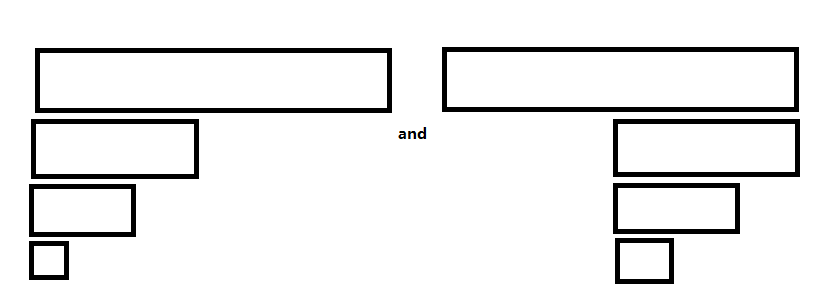[BZOJ] 4756: [Usaco2017 Jan]Promotion Counting #线段树合并+权值线段树
4756: [Usaco2017 Jan]Promotion Counting
Time Limit: 10 Sec Memory Limit: 128 MBSubmit: 298 Solved: 210
[Submit][Status][Discuss]
Description
The cows have once again tried to form a startup company, failing to remember from past experience t
hat cows make terrible managers!The cows, conveniently numbered 1…N1…N (1≤N≤100,000), organize t
he company as a tree, with cow 1 as the president (the root of the tree). Each cow except the presid
ent has a single manager (its "parent" in the tree). Each cow ii has a distinct proficiency rating,
p(i), which describes how good she is at her job. If cow ii is an ancestor (e.g., a manager of a man
ager of a manager) of cow jj, then we say jj is a subordinate of ii.
Unfortunately, the cows find that it is often the case that a manager has less proficiency than seve
ral of her subordinates, in which case the manager should consider promoting some of her subordinate
s. Your task is to help the cows figure out when this is happening. For each cow ii in the company,
please count the number of subordinates jj where p(j)>p(i).
n只奶牛构成了一个树形的公司,每个奶牛有一个能力值pi,1号奶牛为树根。
问对于每个奶牛来说,它的子树中有几个能力值比它大的。
问对于每个奶牛来说,它的子树中有几个能力值比它大的。
Input
The first line of input contains N
The next N lines of input contain the proficiency ratings p(1)…p(N)
for the cows. Each is a distinct integer in the range 1…1,000,000,000
The next N-1 lines describe the manager (parent) for cows 2…N
Recall that cow 1 has no manager, being the president.
n,表示有几只奶牛 n<=100000
接下来n行为1-n号奶牛的能力值pi
接下来n-1行为2-n号奶牛的经理(树中的父亲)
接下来n行为1-n号奶牛的能力值pi
接下来n-1行为2-n号奶牛的经理(树中的父亲)
Output
Please print N lines of output. The ith line of output should tell the number of
subordinates of cow ii with higher proficiency than cow i.
共n行,每行输出奶牛i的下属中有几个能力值比i大
Sample Input
5
804289384
846930887
681692778
714636916
957747794
1
1
2
3
804289384
846930887
681692778
714636916
957747794
1
1
2
3
Sample Output
2
0
1
0
0
0
1
0
0
HINT
Source
Analysis
学习到了一个神级操作 0_o :::::::::::::::::::::::::::::::::::: 线段树合并!
首先我们要给线段树改成:动态开点+散结构+不完整树
我们对一个序列建一棵经典线段树,那么他是长什么样的我们大致都是知道的
但如果要想并查集一样分裂合并的话(分裂还没学呀qwq),首先这棵树得是不完整的
如图,这是一棵经典线段树

那么如果我们对每一个元素建一棵线段树(这样他们最终可以合并成一棵)的话
看起来是这样

上面是两个单个结点的线段树
他们合并后是

那么对于每一层结点,他们只保存这棵线段树内已有的元素的信息
但是就建制而言(就是每一层结点保存的范围),他们是与相同情况下的经典线段树一样的
那么这就显然:原来那套 Lchild = root*2 的方式已经不适用了,应当使用动态开点的方式
关键点一就在此了
题意:查找每一个顶点的子树内数值比该顶点大的点的数量
那么建立一棵权值可合并线段树
权值线段树:指以值为下标的线段树,在经典线段树里需要离散化,但可合并线段树使其实现更加容易
如果是权值线段树的话,那么我们的查询区间就不是元素下标了,而是元素的值域
很棒啊!
具体内容还是需要理解代码,无论是权值线段树还是可合并线段树都没什么太多好讲的
Code

#include<cstdio> #include<iostream> #include<vector> #include<algorithm> #define maxn 1000000 using namespace std; int arr[maxn],disc[maxn],n,ans[maxn]; vector<int> G[maxn]; struct node{ int lc,rc,L,R,sum; }; //namespace SegmentTree{ int root[maxn] = {0},tot = 0; node T[maxn*5]; int maintain(int rt){ T[rt].sum = T[T[rt].lc].sum+T[T[rt].rc].sum; } int build(int L,int R,int pos){ int rt = ++tot,mid = (L+R)/2; T[rt].L = L, T[rt].R = R, T[rt].sum = 0; if(L == R) return T[rt].sum = 1,rt; if(pos <= mid) T[rt].lc = build(L,mid,pos); else T[rt].rc = build(mid+1,R,pos); return maintain(rt),rt; } int query(int rt,int qL,int qR){ if(!rt) return 0; if(qL <= T[rt].L && T[rt].R <= qR) return T[rt].sum; int ret = 0,mid = (T[rt].L+T[rt].R)>>1; if(qL <= mid) ret += query(T[rt].lc,qL,qR); if(qR > mid) ret += query(T[rt].rc,qL,qR); return ret; } int merge(int x,int y){ if(!x||!y) return x^y; T[x].lc = merge(T[x].lc,T[y].lc); T[x].rc = merge(T[x].rc,T[y].rc); return maintain(x),x; } void dfs(int u,int fa){ int res = 0; for(int i = 0;i < G[u].size();i++){ if(G[u][i] == fa) continue; int v = G[u][i]; dfs(v,u); res += query(root[v],arr[u]+1,n); root[v] = merge(root[u],root[v]); }ans[u] = res; } //} int main(){ scanf("%d",&n); for(int i = 1;i <= n;i++) scanf("%d",&arr[i]),disc[i] = arr[i]; sort(disc+1,disc+1+n); int m = unique(disc+1,disc+1+n)-disc-1; for(int i = 1;i <= n;i++) arr[i] = lower_bound(disc+1,disc+1+m,arr[i])-disc; for(int i = 2;i <= n;i++){ int fa; scanf("%d",&fa); G[i].push_back(fa); G[fa].push_back(i); } for(int i = 1;i <= n;i++) root[i] = build(1,n,arr[i]); dfs(1,1); for(int i = 1;i <= n;i++) printf("%d\n",ans[i]); return 0; }
转载请注明出处 -- 如有意见欢迎评论



